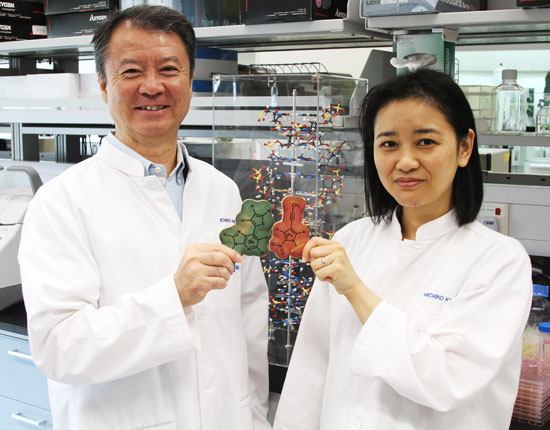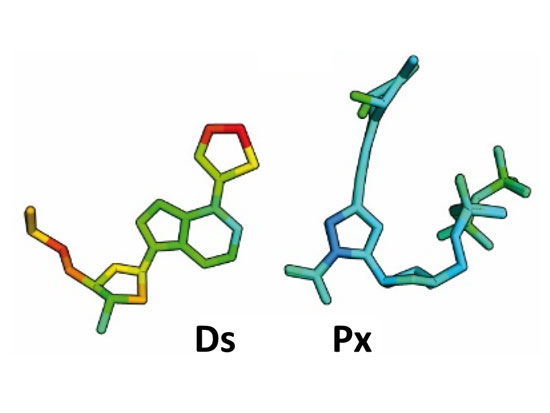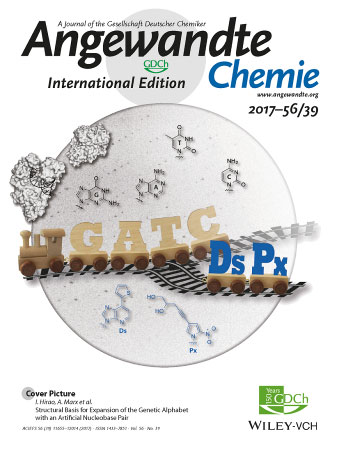A*STAR NEWS
Singapore researchers create new ‘Letters’ to enhance DNA functions
Just like how letters are strung together to form words- our DNA is also strung together by letters to encode proteins. The genetic alphabet contains only 4 natural letters - A- C- G and T- which hold the blueprint for the production of proteins that make our bodies work. Now- researchers from the Institute of Bioengineering and Nanotechnology (IBN) of the Agency for Science- Technology and Research (A*STAR) have created a DNA technology with two new genetic letters that could better detect infectious diseases- such as dengue and Zika.
Genetic alphabet expansion technology is the introduction of artificial base pairs into DNA. The existing four genetic letters are naturally bound together in base pairs of A-T and G-C. These specific base pair formations are essential in DNA replication- which occurs in all living organisms. It is the process by which a DNA molecule is duplicated to produce two identical molecules.
“The expansion of the genetic alphabet is a significant scientific achievement. It sheds insights into DNA’s natural replication mechanism- which will help us to design unique DNA molecules and technologies. For example- our technology can be used to create novel diagnostics and therapeutic agents with superior efficacy-” said IBN Executive Director Professor Jackie Y. Ying.
In 2009- IBN Team Leader and Principal Research Scientist Dr Ichiro Hirao and IBN Senior Research Scientist Dr Michiko Kimoto created two new genetic letters – Ds and Px- which specifically combine with each other to form an artificial base pair that could function as a third DNA base pair. However- the molecular structure of the new base pair had never been determined until they collaborated recently with Professor Andrea Marx from the University of Konstanz in Germany on the structural analysis of their new base pair.
Using X-ray crystallography- the researchers uncovered the 3D molecular structure of the Ds-Px base pair during DNA replication by analyzing the X-ray diffraction through a crystal. They found that the structure of the new artificial base pair was strikingly similar to a natural base pair.
Dr Hirao said- “The inspiration for the design of our new DNA base pair came from jigsaw puzzles- where complementary shapes fit together to form the specific pair. However- our concept had only been a hypothesis until now. We did not know the actual molecular structure of our Ds-Px pair during DNA replication until the recent study with our collaborators at University of Konstanz. They confirmed that we are heading in the right direction- which would allow us to create biological components that can enhance DNA’s natural functions.”
Using this genetic alphabet expansion technology- IBN is developing DNA aptamers- which are modified DNA molecules that can bind to molecular targets in the body. The team plans to launch a test kit using these DNA aptamers to detect infectious diseases- such as dengue and Zika- in the next two years.
This finding was recently published in the September 2017 issue of the journal Angewandte Chemie International Edition as the cover story.
Reference:
- Karin Betz- Michiko Kimoto- Kay Diderichs- Ichiro Hirao and Andrea Marx- “Structural Basis for Expansion of the Genetic Alphabet by an Artificial Base Pair-” Angewandte Chemie International Edition- 56 (2017) 12000. See article
IBN researchers Dr Ichiro Hirao and Dr Michiko Kimoto holding up a jigsaw puzzle inspired model of their new genetic letters – Ds and Px- which can pair up to form the third DNA base pair.
IBN is developing a diagnostic kit using the new DNA base pair (Ds-Px) to improve dengue and Zika detection.
The high-resolution crystal structure of the Ds–Px base pair was featured as the cover story in the September 2017 issue of the journal Angewandte Chemie International Edition. © K. Betz- M. Kimoto- K. Diderichs- I. Hirao and A. Marx: Structural Basis for Expansion of the Genetic Alphabet with an Artificial Nucleobase Pair: Angew. Chem. Int. Ed. 2017. 56. 12000. Copyright Wiley-VCH Verlag GmbH & Co. KGaA. Reproduced with permission.
Institute of Bioengineering and Nanotechnology (IBN)
The Institute of Bioengineering and Nanotechnology (IBN) is the world’s first bioengineering and nanotechnology research institute. Established in 2003- IBN’s mission is to conduct multidisciplinary research across science- engineering- and medicine for breakthroughs to improve healthcare and quality of life. IBN’s research activities are focused on Nanomedicine- Synthetic Biosystems- Biodevices and Diagnostics- and Green Chemistry and Energy. The Institute has published over 1-200 papers in leading scientific journals- filed 661 active patents and patent applications on its inventions- and established 12 spin-off companies. To nurture young research talents- IBN runs a Youth Research Program that offers students research attachment opportunities and exposure to biomedical research.
For more information on IBN- please visit www.a-star.edu.sg/ibn.
About the Agency for Science- Technology and Research (A*STAR)
The Agency for Science- Technology and Research (A*STAR) is Singapore's lead public sector agency that spearheads economic oriented research to advance scientific discovery and develop innovative technology. Through open innovation- we collaborate with our partners in both the public and private sectors to benefit society.
As a Science and Technology Organization- A*STAR bridges the gap between academia and industry. Our research creates economic growth and jobs for Singapore- and enhances lives by contributing to societal benefits such as improving outcomes in healthcare- urban living- and sustainability.
We play a key role in nurturing and developing a diversity of talent and leaders in our Agency and Research Institutes- the wider research community and industry. A*STAR oversees 18 biomedical sciences and physical sciences and engineering research entities primarily located in Biopolis and Fusionopolis.
Was This Article Helpful ?
A*STAR celebrates International Women's Day

From groundbreaking discoveries to cutting-edge research, our researchers are empowering the next generation of female science, technology, engineering and mathematics (STEM) leaders.
Get inspired by our #WomeninSTEM



